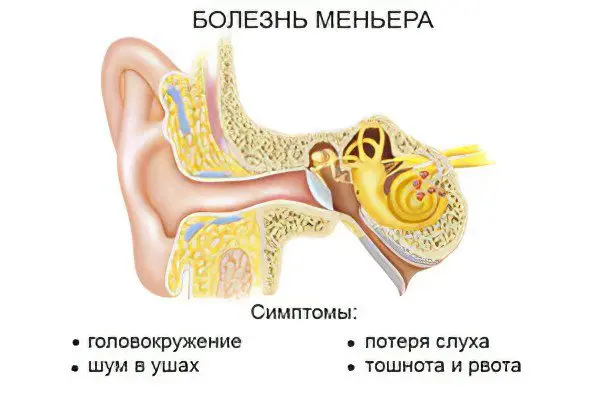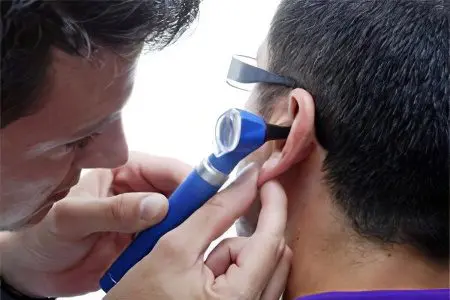Contents

Meniere’s disease is a pathology that affects the inner ear, which has a non-inflammatory character. The disease is expressed in bouts of dizziness, in intermittent noises in the ear, and also in hearing loss.
The disease bears the eponym of the French physician P. Meniere, who in 1861 first described the clinical picture characteristic of this pathology. According to statistics, most often the disease is diagnosed in people aged 25 to 50 years, in pediatrics it occurs, but quite rarely. The number of sick people is equal to 1:1000. People of the Caucasian race are more susceptible to Meniere’s disease, in particular, intellectual workers living in large settlements.
In the vast majority of cases, there is a unilateral ear lesion. Both hearing organs are involved in the pathological process in no more than 15% of cases. However, as the disease progresses, it passes to the second ear in 17-75% of cases over a period of 5 to 30 years.
Meniere’s disease affected such famous people as: A. Shepard (1 American astronaut), D. Swift (satirist, poet, priest), V. Shalamov (Russian writer), R. Adams (American musician).
Symptoms of Meniere’s disease
Symptoms of Meniere’s disease are manifested in the form of attacks, during which the patient experiences:
Dizziness. Often this condition is accompanied by a feeling of nausea and vomiting, which occurs repeatedly. Sometimes dizziness is so strong that a person has the impression that all the surrounding space and objects revolve around him. There may be a feeling of body failure, or its displacement, although the person is in a motionless state. An attack can last from several minutes to several hours. The patient’s condition is aggravated when he tries to turn his head, so he intuitively tries to sit or lie down with his eyes closed. (read also: Dizziness – types and causes)
Loss or severe hearing impairment. At the same time, a person does not hear sounds with a low frequency at all. This clinical sign makes it possible to differentiate Meniere’s disease from hearing loss, in which the patient cannot hear high-pitched sounds. At the same time, a person becomes especially sensitive to loud sound vibrations, and ear pain can occur during increased noise accompaniment.
Tinnitus. Ringing occurs regardless of whether there is a source of noise in the human environment. The ringing is whistling, muffled, some patients compare it with the ringing of a bell. Before the onset of an attack, the ringing tends to increase, and during the attack itself it can change.
Feeling of pressure, congestion in the ear. The feeling of discomfort and fullness occurs due to the accumulation of fluid in the cavity of the inner ear. This feeling is especially strong before the onset of an attack.
Diarrhea, stomach ache.
Headache.
Shortness of breath, tachycardia, blanching of the skin of the face, increased sweating.
Nystagmus observed during an attack – rapid oscillatory movements of the eyeballs. Strengthening of nystagmus is noted at a time when the patient lies on the damaged ear.
Sudden fall. This is a rather formidable symptom that occurs due to impaired coordination. This violation is associated with deformation of the structures of the inner ear, which causes the activation of vestibular reflexes. In this case, the patient shakes from side to side, sometimes he falls, or changes his position, in an attempt to maintain balance. The main danger lies in the fact that there are no forerunners of the forthcoming activation of vestibular reflexes. Therefore, during a fall, a person can be seriously injured.
After the attack ends, the person retains hearing loss, there may be noise in the ear, a feeling of heaviness in the head. Unsteady gait and coordination disorders are also observed. The patient experiences a feeling of weakness. As the disease progresses, all of these symptoms tend to increase and become more prolonged over time.
Hearing loss is progressive. If at the very beginning of Meniere’s disease a person hardly distinguishes low-frequency sounds, then subsequently he does not hear the entire sound range. Hearing loss eventually turns into absolute deafness. When a person becomes deaf, the attacks of dizziness stop.
The onset of the disease is characterized by the fact that periods of exacerbations are replaced by periods of remission, during which hearing is fully restored, there is no loss of ability to work. Transient hearing loss usually persists for the first 2-3 years of illness. As the disease progresses, even during the period of remission, there is no complete restoration of hearing, vestibular disorders persist, and performance decreases.
Most patients with Meniere’s disease are able to anticipate an approaching attack, as it is preceded by a certain aura. It is expressed in a violation of coordination of movements, a growing ringing appears in the ears. In addition, there is a feeling of pressure and fullness in the ear. In some cases, before the attack itself, there is a temporary improvement in hearing.
Depending on what the symptoms of Meniere’s disease are, it is possible to determine the degree of progression of the pathology:
For the first stage the leading symptom is considered to be dizziness with vomiting and nausea, while blanching of the skin occurs, hyperhidrosis is observed. Hearing persists between attacks.
For the second stage the disease is characterized by the development of hearing loss, dizziness have a maximum severity, with a subsequent tendency to weaken.
For the third stage Hearing loss and development of bilateral deafness are characteristic. At the same time, dizziness disappears altogether, but coordination disorders persist and intensify when the patient is in the dark.
These three stages characterize the classical course of Meniere’s disease, that is, the onset of the pathological process is manifested by a combination of vestibular and auditory disorders. 30% of all patients suffer from this form of the disease. In addition, there is also a cochlear (begins only with auditory disorders) and vestibular (begins with vestibular disorders) form of the disease. They account for 50% and 20% of cases, respectively.
Causes of Meniere’s disease

It has not yet been possible to establish the exact causes of Meniere’s disease, although the clinical signs of the disease have been described for more than 150 years ago. Naturally, scientists have several hypotheses regarding the factors that influence the etiology of this pathology.
The main theories of the development of the disease:
anatomical theory. Scientists believe that the disease can develop as a result of the anatomical pathology of the structure of the temporal bone.
genetic theory indicates that the disease develops due to its transmission by inheritance. According to recent scientific studies, it was found that the pathology is transmitted by an autosomal dominant type of inheritance.
virus theory. According to her, the disease occurs as a result of the influence of a viral infection, for example, as a result of exposure to cytomegalovirus or herpes simplex virus.
Allergic theory indicates that there is a link between allergies and Meniere’s disease. It has been found that, unlike the general population, allergic reactions in people with Meniere’s disease are much more common.
Vascular theory associated with migraine. Meniere himself pointed out this fact.
immunological theory indicates that immune complexes are found in the endolymphatic sac in people with Ménière’s disease.
metabolic theory associates the disease with potassium retention in the endolymphatic space. For this reason, intoxication of the hair cells occurs, which provokes dizziness and the formation of hearing loss.
Most scientists are of the opinion that Meniere’s disease is a polyetiological pathology, that is, its development is influenced by several factors at the same time.
Provocative reasons can be:
Transferred viral diseases of the middle ear;
Head and ear injuries;
Congenital anomalies in the development of the hearing organs;
Errors in nutrition with a violation of water-salt metabolism;
Lack of estrogen in the body;
Professional hazards.
The following external influences are capable of provoking the onset of another attack:
Physical fatigue;
stressful situations;
Binge eating;
Inhalation of tobacco smoke;
Reception of alcoholic beverages;
Increase in body temperature;
Medical procedures performed in the ear;
Pronounced noisy environment.
Diagnosis of Meniere’s disease
Diagnosis of Meniere’s disease is not particularly difficult and is built on the basis of clinical signs and according to instrumental examinations, among which audiometry is the leading one.
The American Academy of Surgery and Otolaryngology has identified the following diagnostic criteria confirming the presence of Meniere’s disease:
More than two bouts of dizziness lasting 20 minutes or longer;
Hearing loss according to audiometry;
Noise in the ears, complaints of a feeling of congestion in the ear;
The absence of other causes leading to this symptomatology.
During the performance of audiometry, a mixed nature of hearing impairment is detected. At the initial stage of the development of the disease, hearing is reduced in the low frequency range, and as the pathology progresses, audibility disappears at all frequencies.
There are several types of diagnosis of Meniere’s disease:
With the help of such a diagnostic method as acoustic impedancemetry, it is possible to assess the mobility of the auditory ossicles and the work of the intra-ear muscles.
The promontory test allows you to determine the presence of disorders in the functioning of the auditory nerve.
Methods such as otoscopy and microotoscopy make it possible to exclude the presence of inflammation.
Brain MRI is indicated to confirm the absence of acoustic neuroma.
Deviations in the functioning of the vestibular apparatus are detected using indirect otolithometry, vestibulometry, and stabilography.
In addition, it is possible to consult a patient with a neurologist, who directs the patient to ECHO-EG, EEG, REG, duplex scanning of cerebral vessels.
The glycerol test allows you to assess the state of endolymphatic pressure, the increase of which underlies the disease. For the test, the patient will need to drink a mixture of fruit juice and glycerin calculated based on their body weight. After 2 hours, audiometry is performed and the patient’s hearing condition is assessed. If at 3 frequencies it decreases by 10 dB, then the test is considered positive.
It is important during the diagnosis to differentiate Meniere’s disease with other pathologies of the organ of hearing, such as: otosclerosis, eustachitis, otitis media, tumors, vestibular neuronitis, etc.
Treatment of Meniere’s disease

Treatment of Meniere’s disease is aimed at stopping its progression and achieving control over the symptoms of the pathology. To rid a person of Meniere’s disease is completely beyond the power of modern medicine.
If we take into account the provocative factors that stimulate the development of seizures, then controlling their frequency can be quite simple. To do this, it is necessary to maintain a healthy lifestyle, follow a diet, stop overeating, drinking alcohol and smoking.
To control the attack, it is possible to prescribe the following means:
Antihistamines (Trimethobenzamide, Meclozin);
Remedies for nausea;
Vasodilators of general action (Nikospan, No-shpa);
Neuroleptics (Triftazine, Aminazine);
Betahistine, as a drug that dilates the vessels of the inner ear.
Most often, an attack can be stopped without hospitalization of the patient. However, if the patient has repeated bouts of vomiting, he will need intravenous administration of antiemetics.
In order to reduce the amount of retained fluid, diuretics are recommended. This allows you to normalize the pressure that is created in the inner ear. The most common combination is the appointment of hydrochlorothiazide and triamterene.
Diuretics are recommended to be taken for a long time, therefore, in parallel, the patient should follow a diet with a high content of minerals. The fact is that drugs of this group, together with excess fluid, wash out useful substances from the body.
Meniere’s syndrome is treated with an injection directly into the middle ear. This conservative method has an effect close to the effect of the operation.
The following funds are subject to introduction:
Antibiotic Gentamicin, which can reduce the number of seizures and reduce their intensity. However, the risk of such treatment is associated with the possibility of complete hearing loss.
Hormones Prednisolone, Dexamethasone also allow you to control the patient’s condition. However, hormones are not as effective as gentamicin injections. But the risk of hearing loss is also reduced, which is their undoubted advantage.
When the effect of the therapy is absent, it is possible to perform surgical treatment. However, even surgery cannot guarantee hearing preservation.
Operations can be of the following types:
Destructive interventions are the removal of the labyrinth, the intersection of the 8th nerve branch, laser destruction of the labyrinth, etc.
Drainage interventions are aimed at enhancing the outflow of the endolithm from the ear cavity. To do this, drainage of the labyrinth, perforation of the base of the stirrup, drainage of the endolymphatic sac can be performed.
Operations on the autonomic nervous system are reduced to resection of the tympanic string, to the intersection of the tympanic plexus, or to cervical sympathectomy.
As for the prognosis for the development of the disease, Meniere’s disease does not lead to death, although it is currently incurable. Timely medical treatment can slow down the progression of hearing loss. If hearing continues to deteriorate, wearing a hearing aid or implant may be appropriate.
Disability in Meniere’s disease
Disability in Meniere’s disease is most often not assigned.
Only those patients who have other incurable chronic diseases on the background of Meniere’s disease can receive it, as well as under the following conditions:
Severe and irreversible hearing loss;
The presence of a severe concomitant disease;
The lack of effectiveness of the ongoing treatment against the background of frequent long-term attacks that have been documented;
The presence of vestibulo-atactic syndrome of moderate (group 3), severe (group 2) or pronounced (group 1) degree.
In any case, the decision to assign a particular disability group to a patient will be decided by a special medical commission. Most often, disability is received by people of retirement age, in whom the disease debuted in youth or in childhood.









